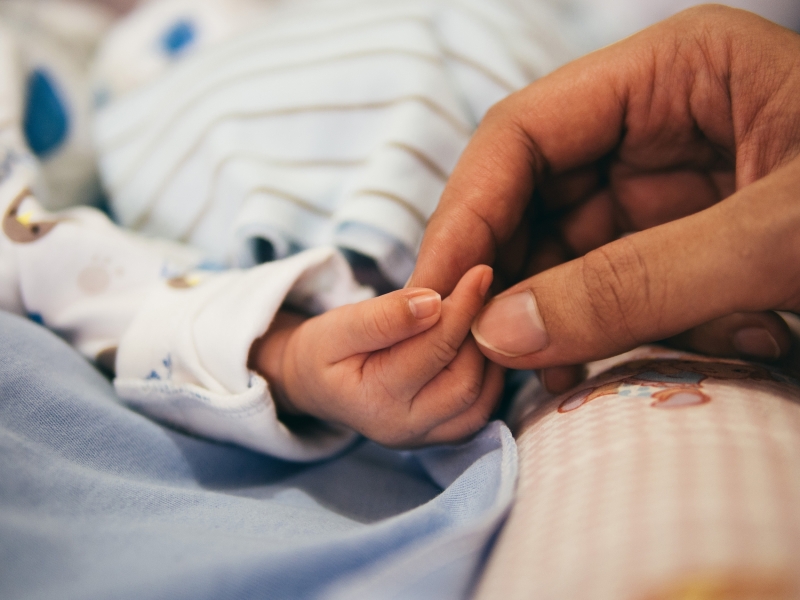A child’s immunity builds up gradually until about 6 to 8 years. It is therefore no surprise that during the first years, children “brush off” a whole string of ailments. Some die down quickly, others hang around for longer. What disease is your baby likely to have during the first year of life? We asked paediatrician Dr. Lucie Skalova.
Colds
The most common diseases in infants and toddlers include diseases of the upper respiratory tract, i.e. the common cold. It is most often caused by viruses. It is spread by droplet infection, so it is important that the baby, and especially a newborn, is not unnecessarily exposed to places with a large concentration of people, such as shopping centres. “The best prevention is proper hand hygiene, keeping visits to a minimum, especially if you too suffer from an acute cold, air the home sufficiently and, if possible, breastfeed. It is advisable to go to a doctor with a newborn or smaller infant if there is also a fever, the baby doesn’t drink or urinate enough, if the cold persists and the mucous is yellow to green, the cough begins to worsen or there is also shortness of breath,” states Dr. Lucie Skalova.
Tummy ache
From time to time babies can also experience vomiting or diarrhoea. It is especially dangerous for infants and toddlers, because it involves a rapid loss of minerals and fluids (dehydration). “See your doctor if the child can’t hold any fluids or has very frequent loose stools, it starts being tired or sleepy more often, it urinates less, has a dry tongue or lips,” says Dr. Skalova. Diarrhoea is not so common in breastfed babies, as the composition of breast milk provides them with a certain amount of protection.
Vomiting can be more common in babies. Reflux can also be to blame. “It concerns a relaxation of the oesophageal sphincter and the contents of the stomach are subsequently returned to the oesophagus and the oral cavity. During reflux, the baby usually brings up milk even a few hours after a meal. It is not vomiting as such, in most children the frequency of occurrence and the problems associated with it decrease with age. During reflux, feed the baby in a raised position, then wind it for a suitabl;y long time and when putting it to bed ensure it is in a raised position. When feeding the baby with artificial nutrition, you can use Nutriton or a rice decoction to thicken the milk,” explains Dr. Skalova.
Allergies
Unfortunately, nowadays allergic reactions in babies are not unusual. The most common manifestation is hives or atopic infant eczema. The treatment for atopic eczema is long-term and complex. The most important is the composition of the breast milk - i.e. be careful what a breastfeeding mother eats, because everything gets into the breast milk. The most common food allergens, such as tomatoes, strawberries, chocolate, cocoa, apricots, sometimes capsicums, dairy products, fish or eggs, should be avoided. It is necessary to try and monitor what makes the eczema worse for the child. There are also genetic predispositions to atopic eczema. Therefore, if one of the parents is atopic (suffers from allergies), it increases the probability that the child may also suffer from allergies. Breastfeeding has been repeatedly shown to be the best way to prevent allergies. If you feed your baby formula, you can use hypoallergenic milk, called HA (milk in which the cows milk protein has been broken down into smaller pieces so they have less antigenic potential and the risk of allergies is lower, ed. note).
“Atopic eczema usually worsens during an acute illness, then in the summer when it is warmer and the child sweats. Wear cotton clothing, not synthetic materials, change the baby often and let the skin air. It is recommended to shower only and lightly drying the baby afterwards and then lubricating the skin. If the skin is very red, you can also try short oatmeal baths. As for the phase of eczema, when the skin suppurates, it is necessary to dry it, for example, poultices made of black tea or poultices made of chamomile tea,” adds Dr. Skalova.
Childhood diseases
Until they infect your baby, the names of these diseases probably won’t tell you anything. They are typical childhood diseases. To be specific, they are the fifth and sixth diseases. Preschoolers are most often ill with the fifth disease. In the first phase, it looks similar to a cold. A temperature or fever, general weakness, tiredness, muscle and joint pain. After a few days, a typical rash appears on the nose and on the cheeks, which resembles a butterfly in shape. The rash gradually spreads to the trunk and limbs. The disease disappears on its own even without treatment. The keystone is rest and plenty of fluids.
The sixth disease is most common among infants and toddlers. The infection starts with a fever lasting for 2-3 days, and after the fever drops, a rash breaks out. It spreads along the torso to the neck and disappears of its own accord in a few days. Even though the disease’s course may look dramatic, it is relatively harmless and is gone within a week. However, if your baby has a high fever at the start of the illness, it is best to see a paediatrician to rule out any other infections.
How to prevent diseases
You can avoid many diseases by prevention. What are the most important measures? Breastfeeding in the first year is a very reliable protection. Walking in the fresh air or airing and humidifying rooms will also strengthen immunity. It is also important not to forget to wash your hands properly."

